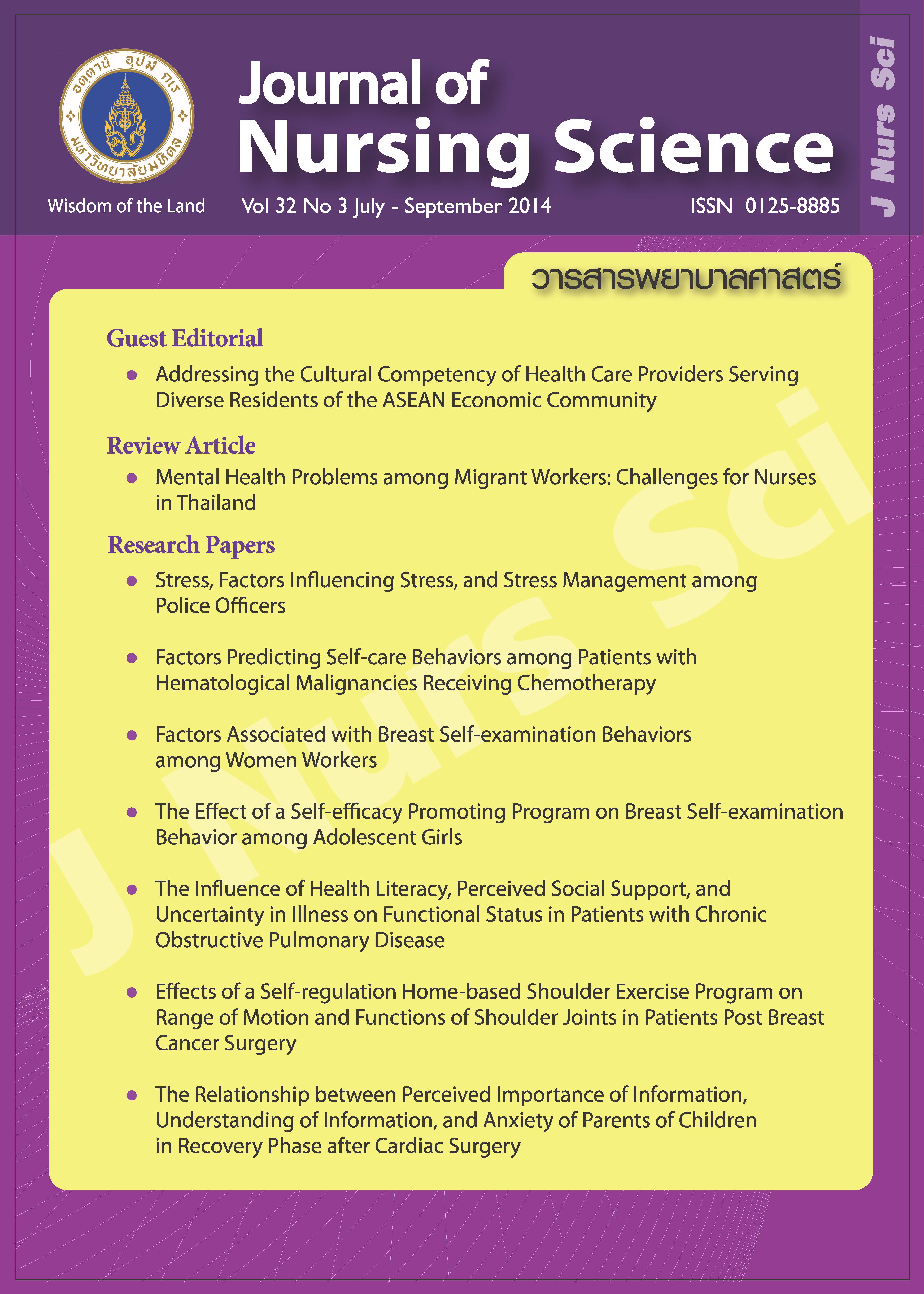Factors Associated with Breast Self-examination Behaviors among Women Workers
Main Article Content
Abstract
Purpose: This study was aimed at investigating factors related to breast self-examination behaviors including predisposing factors: knowledge of breast cancer, attitude toward breast cancer, confidence in breast self-examination; enabling factors: convenience in breast self-examination; and reinforcing factors: social support among women workers.
Design: Descriptive correlational research.
Methods: The study sample consisted of 116 women workers who worked at enterprises in Khoasaming District, Trat Province. Data were collected by means of administering a set of questionnaires: demographic characteristics, a knowledge of breast cancer, an attitude toward breast cancer, a confidence in breast selfexamination, a convenience in breast self-examination, and a social support. Relationships among the study variables were determined using Spearman’s rank correlation.
Main findings: The study findings revealed that 11.2% of the women workers performed breast selfexamination on a monthly basis. More than half, or 55.2%, had a low level of correctness in breast selfexamination. It was also found that the factors of knowledge (r = .35, p < .001), confidence (r = .35, p < .001), convenience (r = .22, p < .05), and social support (r = .25, p < .05) were related to breast self-examination behaviors among women workers with statistical significance. However, there was no relationship between attitude toward breast cancer and breast self-examination behaviors among women workers.
Conclusion and recommendations: Nurses in enterprises and related healthcare team members should promote knowledge of breast cancer, particularly breast self-examination methods, among women workers. Nurses should also encourage them to be confident in observing abnormalities of the breasts using palpation technique as well as facilitate advisory services in a hospital or staff rooms.
Keywords: breast self-examination behaviors, women workers
ปัจจัยที่มีความสัมพันธ์ต่อพฤติกรรมการตรวจเต้านมด้วยตนเองของสตรีวัยแรงงาน
บทคัดย่อ
วัตถุประสงค์: เพื่อศึกษาความสัมพันธ์ระหว่างปัจจัยนำ ได้แก่ ความรู้เกี่ยวกับมะเร็งเต้านม ทัศนคติต่อมะเร็งเต้านม ความมั่นใจต่อการตรวจเต้านมด้วยตนเอง ปัจจัยเอื้อ ได้แก่ ความสะดวกในการตรวจเต้านมด้วยตนเอง และปัจจัยเสริม ได้แก่ แรงสนับสนุนทางสังคม กับพฤติกรรมการตรวจเต้านมด้วยตนเองของสตรีวัยแรงงาน
รูปแบบการวิจัย: การวิจัยศึกษาความสัมพันธ์เชิงพรรณนา
วิธีดำเนินการวิจัย: กลุ่มตัวอย่างคือ สตรีวัยแรงงานที่ทำงานในสถานประกอบกิจการ อำเภอเขาสมิง จังหวัดตราด จำนวน 116 คน เก็บรวบรวมข้อมูลโดยใช้แบบสอบถามข้อมูลทั่วไป ความรู้เกี่ยวกับมะเร็งเต้านม ทัศนคติต่อมะเร็งเต้านม ความมั่นใจต่อการตรวจเต้านมด้วยตนเอง ความสะดวกในการตรวจเต้านมด้วยตนเอง และการได้รับแรงสนับสนุนทางสังคม วิเคราะห์ความสัมพันธ์โดยใช้สถิติสหสัมพันธ์สเปียร์แมน
ผลการวิจัย: สตรีวัยแรงงานตรวจเต้านมด้วยตนเองสม่ำเสมอทุกเดือนเพียงรอ้ ยละ 11.2 โดยตรวจถูกต้องในระดับ ต่ำร้อยละ 55.2 และพบตวั แปรที่มีความสัมพันธ์กับพฤติกรรมการตรวจเต้านมด้วยตนเองของสตรีวัยแรงงานอย่างมีนัยยสำคัญทางสถิติ ได้แก่ ความรู้เกี่ยวกับมะเร็งเต้านม (r = .35, p < .001) ความมั่นใจต่อการตรวจเต้านมด้วยตนเอง (r = .35, p < .001) ความสะดวกในการตรวจเต้านมด้วยตนเอง (r = .22, p < .05) แรงสนับสนุนทางสังคม (r = .25, p < .05) และไม่พบความสัมพันธ์ระหว่างทัศนคติต่อมะเร็งเต้านมกับพฤติกรรมการตรวจเต้านมด้วยตนเอง
สรุปและข้อเสนอแนะ: พยาบาลประจำสถานประกอบกิจการหรือบุคลากรทีมสุขภาพที่เกี่ยวข้องควรมีการส่งเสริมให้ความรู้เกี่ยวกับมะเร็งเต้านม โดยเฉพาะวิธีการตรวจเต้านมด้วยตนเอง และเสริมสร้างความมั่นใจในประเด็นของการสังเกตความผิดปกติของเต้านม และการตรวจโดยการคลำ รวมทั้งจัดอำนวยความสะดวกโดยการหาแหล่งบริการคำแนะนำในห้องพยาบาลหรือห้องพักพนักงาน และประสานกับเจ้าของสถานประกอบกิจการเพื่อจัดกิจกรรมที่เหมาะสมกับสตรีวัยแรงงาน
คำสำคัญ: พฤติกรรมการตรวจเต้านมด้วยตนเอง สตรีวัยแรงงาน
Article Details
Copyright Notice: Nursing Science Journal of Thailand has exclusive rights to publish and distribute the manuscript and all contents therein. Without the journal’s permission, the dissemination of the manuscript in another journal or online, and the reproduction of the manuscript for non-educational purpose are prohibited.

Disclaimer: The opinion expressed and figures provided in this journal, NSJT, are the sole responsibility of the authors. The editorial board bears no responsibility in this regard.


